Effect of Ferric Ions on Sulfidization Flotation of Oxidize Digenite Fine Particles and Their Significance
Abstract
:1. Introduction
2. Materials and Methods
2.1. Mineral Samples and Reagents
2.2. Microflotation Experiments
2.3. Adsorption Experiments
2.4. Zeta Potential Measurements
2.5. Contact Angle Measurements
2.6. XPS Analyses
2.7. Optical Microscopy Analysis
3. Results
3.1. Microflotation Tests
3.2. Fe3+ Adsorption Experiments
3.3. Zeta Potential Measurements
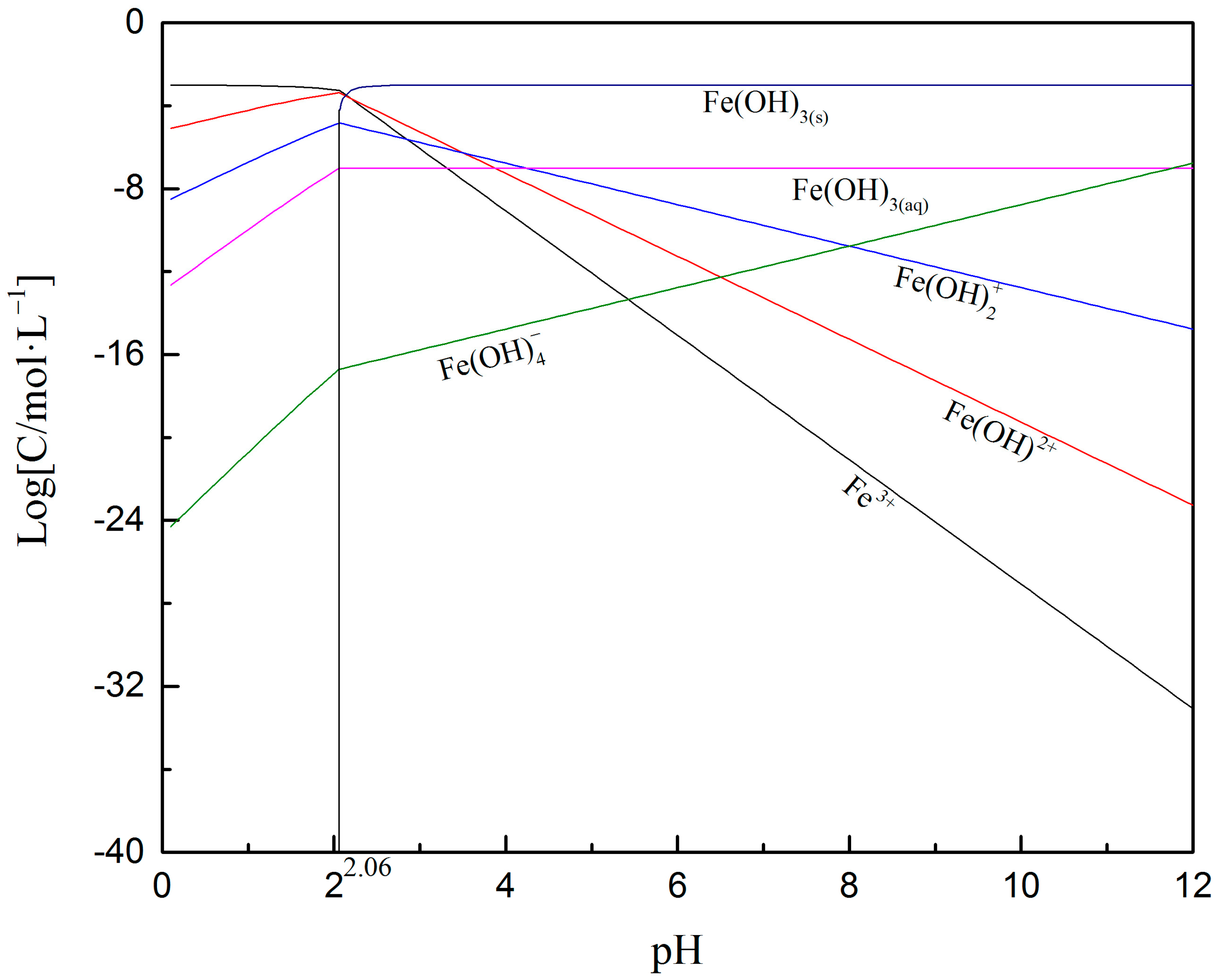
3.4. Contact Angle Measurements
3.5. XPS Analysis
3.6. Optical Microscopy Analysis
4. Conclusions
- A low dosage of Fe3+ had no significant effect on the sulfidization flotation of oxidized digenite fine particles. However, as the Fe3+ dosage exceeded 5 × 10−4 mol/L, both the flotation rate and recovery of digenite significantly decreased.
- Fe3+ can adsorb on the surface of oxidized digenite fine particles mainly in the form of hydrophilic Fe(OH)3 species, hindering the effective sulfidization of digenite, which decreases the surface hydrophobicity, and further prevents the flotation recovery of digenite.
- With the addition of Na2S and SBX, a remarkable agglomeration performance of oxidized digenite fine particles was observed, which was the main reason for the good floatability of digenite. However, the presence of Fe3+ prevents the formation of hydrophobic agglomerates, resulting in a low flotation rate and recovery of digenite.
- This study is of great significance for realizing the effective separation of oxidized digenite fine particles and iron sulfide minerals. When the amount of Fe3+ dissolved from oxidized iron sulfide minerals is less than a critical value, digenite can be recovered using sulfidization technology. However, once the dissolved Fe3+ exceeds the critical value, measurements must be taken before sulfidization to desorb the Fe3+ species adsorbed on the surface and decrease the amount of Fe3+ in the pulp.
Author Contributions
Funding
Institutional Review Board Statement
Informed Consent Statement
Data Availability Statement
Conflicts of Interest
References
- Schipper, B.W.; Lin, H.C.; Meloni, M.A.; Wansleeben, K.; Heijungs, R.; van der Voet, E. Estimating global copper demand until 2100 with regression and stock dynamics. Resour. Conserv. Recycl. 2018, 132, 28–36. [Google Scholar] [CrossRef]
- Liu, S.; Zhang, Y.; Su, Z.; Lu, M.; Gu, F.; Liu, J.; Jiang, T. Recycling the domestic copper scrap to address the China’s copper sustainability. J. Mater. Res. Technol. 2020, 9, 2846–2855. [Google Scholar] [CrossRef]
- Bilal, M.; Ito, M.; Koike, K.; Hornn, V.; Ul Hassan, F.; Jeon, S.; Park, I.; Hiroyoshi, N. Effects of coarse chalcopyrite on flotation behavior of fine chalcopyrite. Miner. Eng. 2021, 163, 106776. [Google Scholar] [CrossRef]
- Yin, W.; Tang, Y. Interactive effect of minerals on complex ore flotation: A brief review. Int. J. Miner. Metall. Mater. 2020, 27, 571–583. [Google Scholar] [CrossRef]
- Sivamohan, R. The problem of recovering very fine particles in mineral processing—A review. Int. J. Miner. Process. 1990, 28, 247–288. [Google Scholar] [CrossRef]
- Subrahmanyam, T.V.; Forssberg, K.S.E. Fine particles processing: Shear-flocculation and carrier flotation—A review. Int. J. Miner. Process. 1990, 30, 265–286. [Google Scholar] [CrossRef]
- Finkelstein, N.P. Addendum to: The activation of sulphide minerals for flotation: A review. Int. J. Miner. Process. 1999, 55, 283–286. [Google Scholar] [CrossRef]
- Deng, J.; Wen, S.; Xian, Y.; Liu, J.; Bai, S. New discovery of unavoidable ions source in chalcopyrite flotation pulp: Fluid inclusions. Miner. Eng. 2013, 42, 22–28. [Google Scholar] [CrossRef]
- Bai, S.; Wen, S.; Xian, Y.; Liu, J.; Deng, J. New source of unavoidable ions in galena flotation pulp: Components released from fluid inclusions. Miner. Eng. 2013, 45, 94–99. [Google Scholar] [CrossRef]
- Peng, Y.; Grano, S.; Fornasiero, D.; Ralston, J. Control of grinding conditions in the flotation of galena and its separation from pyrite. Int. J. Miner. Process. 2003, 70, 67–82. [Google Scholar] [CrossRef]
- Ma, Y.; Huang, F.; Yin, W.; Tang, Y.; Zhang, S. Influence and mechanism of Fe3+ on flotation of digenite. Chin. J. Nonferrous Met. 2018, 28, 817–822. (In Chinese) [Google Scholar]
- Liu, R.; Liu, D.; Li, J.; Li, J.; Liu, Z.; Jia, X.; Yang, S.; Li, J.; Ning, S. Sulfidization mechanism in malachite flotation: A heterogeneous solid-liquid reaction that yields CuxSy phases grown on malachite. Miner. Eng. 2020, 154, 106420. [Google Scholar] [CrossRef]
- Wang, H.; Wen, S.; Han, G.; Feng, Q. Applied Surface Science Modification of malachite surfaces with lead ions and its contribution to the sulfidization flotation. Appl. Surf. Sci. 2021, 550, 149350. [Google Scholar] [CrossRef]
- Zhang, Q.; Wen, S.; Feng, Q.; Liu, J. Surface modification of azurite with lead ions and its effects on the adsorption of sulfide ions and xanthate species. Appl. Surf. Sci. 2021, 543, 148795. [Google Scholar] [CrossRef]
- Liu, R.; Liu, D.; Li, J.; Liu, S.; Liu, Z.; Gao, L.; Jia, X.; Ao, S. Improved understanding of the sulfidization mechanism in cerussite flotation: An XPS, ToF-SIMS and FESEM investigation. Colloids Surf. A 2020, 595, 124508. [Google Scholar] [CrossRef]
- Orwe, D.; Grano, S.R.; Lauder, D.W. Increasing fine copper recovery at the Ok Tedi concentrator, Papua New Guinea. Miner. Eng. 1998, 11, 171–187. [Google Scholar] [CrossRef]
- Newell, A.J.H.; Skinner, W.M.; Bradshaw, D.J. Restoring the floatability of oxidised sulfides using sulfidisation. Int. J. Miner. Process. 2007, 84, 108–117. [Google Scholar] [CrossRef]
- Moimane, T.; Huai, Y.; Peng, Y. Evaluating the sulphidisation and flotation of oxidised chalcopyrite. Miner. Eng. 2021, 164, 106816. [Google Scholar] [CrossRef]
- Cao, Z.; Chen, X.; Peng, Y. The role of sodium sulfide in the flotation of pyrite depressed in chalcopyrite flotation. Miner. Eng. 2018, 119, 93–98. [Google Scholar] [CrossRef]
- Xu, M. Modified flotation rate constant and selectivity index. Miner. Eng. 1998, 11, 271–278. [Google Scholar] [CrossRef]
- Zhang, N.; Zhou, C.; Liu, C.; Pan, J.; Tang, M.; Cao, S.; Ouyang, C.; Peng, C. Bin Effects of particle size on flotation parameters in the separation of diaspore and kaolinite. Powder Technol. 2017, 317, 253–263. [Google Scholar] [CrossRef]
- Natarajan, R.; Nirdosh, I. Effect of molecular structure on the kinetics of flotation of a Canadian nickel ore by N-arylhydroxamic acids. Int. J. Miner. Process. 2009, 93, 284–288. [Google Scholar] [CrossRef]
- Yao, J.; Sun, H.; Han, F.; Yin, W.; Hong, J.; Wang, Y.; Won, C.; Du, L. Enhancing selectivity of modifier on magnesite and dolomite surfaces by pH control. Powder Technol. 2020, 362, 698–706. [Google Scholar] [CrossRef]
- Li, Z.; Han, Y.; Gao, P.; Wang, H.; Liu, J. The interaction among multiple charged particles induced by cations and direct force measurements by AFM. Colloids Surf. A 2020, 589, 124440. [Google Scholar] [CrossRef]
- Yang, B.; Yin, W.; Zhu, Z.; Sun, H.; Sheng, Q.; Fu, Y.; Yao, J.; Zhao, K. Differential adsorption of hydrolytic polymaleic anhydride as an eco-friendly depressant for the selective flotation of apatite from dolomite. Sep. Purif. Technol. 2021, 256, 117803. [Google Scholar] [CrossRef]
- Liu, W.; Liu, W.; Wang, B.; Duan, H.; Peng, X.; Chen, X.; Zhao, Q. Novel hydroxy polyamine surfactant N-(2-hydroxyethyl)-N-dodecyl-ethanediamine: Its synthesis and flotation performance study to quartz. Miner. Eng. 2019, 142, 105894. [Google Scholar] [CrossRef]
- Zhu, Z.; Wang, D.; Yang, B.; Yin, W.; Ardakani, M.S.; Yao, J.; Drelich, J.W. Effect of nano-sized roughness on the flotation of magnesite particles and particle-bubble interactions. Miner. Eng. 2020, 151, 106340. [Google Scholar] [CrossRef]
- Fullston, D.; Fornasiero, D.; Ralston, J. Zeta potential study of the oxidation of copper sulfide minerals. Colloids Surf. A 1999, 146, 113–121. [Google Scholar] [CrossRef]
- Wang, D.; Hu, Y. Solution Chemistry of Flotation; Hunan Science and Technology Press: Changsha, China, 1988; pp. 132–134. [Google Scholar]
- Dong, J.; Liu, Q.; Yu, L.; Subhonqulov, S.H. The interaction mechanism of Fe3+ and NH4+ on chalcopyrite surface and its response to flotation separation of chalcopyrite from arsenopyrite. Sep. Purif. Technol. 2021, 256, 117778. [Google Scholar] [CrossRef]
- Moimane, T.; Huai, Y.; Peng, Y. The critical degree of bornite surface oxidation in flotation. Miner. Eng. 2020, 155, 106445. [Google Scholar] [CrossRef]
- Moimane, T.; Plackowski, C.; Peng, Y. The critical degree of mineral surface oxidation in copper sulphide flotation. Miner. Eng. 2020, 145, 106075. [Google Scholar] [CrossRef]
- Hirajima, T.; Miki, H.; Suyantara, G.P.W.; Matsuoka, H.; Elmahdy, A.M.; Sasaki, K.; Imaizumi, Y.; Kuroiwa, S. Selective flotation of chalcopyrite and molybdenite with H2O2 oxidation. Miner. Eng. 2017, 100, 83–92. [Google Scholar] [CrossRef]
- Liu, J.; Liu, G.; Yang, X.; Dong, Y.; Zhang, Z. 6-Hexyl-1,2,4,5-tetrazinane-3-thione: Flotation selectivity and mechanism to copper sulfide mineral. Miner. Eng. 2020, 152, 106345. [Google Scholar] [CrossRef]
- Yu, L.; Liu, Q.; Li, S.; Deng, J.; Luo, B.; Lai, H. Depression mechanism involving Fe3+ during arsenopyrite flotation. Sep. Purif. Technol. 2019, 222, 109–116. [Google Scholar] [CrossRef]
- Cao, Z.; Wang, P.; Zhang, W.; Zeng, X.; Cao, Y. Mechanism of sodium sulfide on flotation of cyanide-depressed pyrite. Trans. Nonferrous Met. Soc. China 2020, 30, 484–491. [Google Scholar] [CrossRef]
- Mikhlin, Y.; Karacharov, A.; Tomashevich, Y.; Shchukarev, A. Cryogenic XPS study of fast-frozen sulfide minerals: Flotation-related adsorption of n-butyl xanthate and beyond. J. Electron Spectros. Relat. Phenom. 2016, 206, 65–73. [Google Scholar] [CrossRef]
- Tian, M.; Liu, R.; Gao, Z.; Chen, P.; Han, H.; Wang, L.; Zhang, C.; Sun, W.; Hu, Y. Activation mechanism of Fe (III) ions in cassiterite flotation with benzohydroxamic acid collector. Miner. Eng. 2018, 119, 31–37. [Google Scholar] [CrossRef]
- Niu, X.; Chen, J.; Li, Y.; Xia, L.; Li, L.; Sun, H.; Ruan, R. Correlation of surface oxidation with xanthate adsorption and pyrite flotation. Appl. Surf. Sci. 2019, 495, 143411. [Google Scholar] [CrossRef]
- Song, S.; Lopez-Valdivieso, A.; Reyes-Bahena, J.L.; Bermejo-Perez, H.I.; Trass, O. Hydrophobic flocculation of galena fines in aqueous suspensions. J. Colloid Interface Sci. 2000, 227, 272–281. [Google Scholar] [CrossRef] [PubMed] [Green Version]
- Song, S.; Lopez-Valdivieso, A.; Reyes-Bahena, J.L.; Bermejo-Perez, H.I. Hydrophobic flocculation of sphalerite fines in aqueous suspensions induced by ethyl and amyl xanthates. Colloids Surf. A 2001, 181, 159–169. [Google Scholar] [CrossRef]
- Cheng, W.; Deng, Z.; Tong, X.; Lu, T. Hydrophobic agglomeration of fine pyrite particles induced by flotation reagents. Minerals 2020, 10, 801. [Google Scholar] [CrossRef]
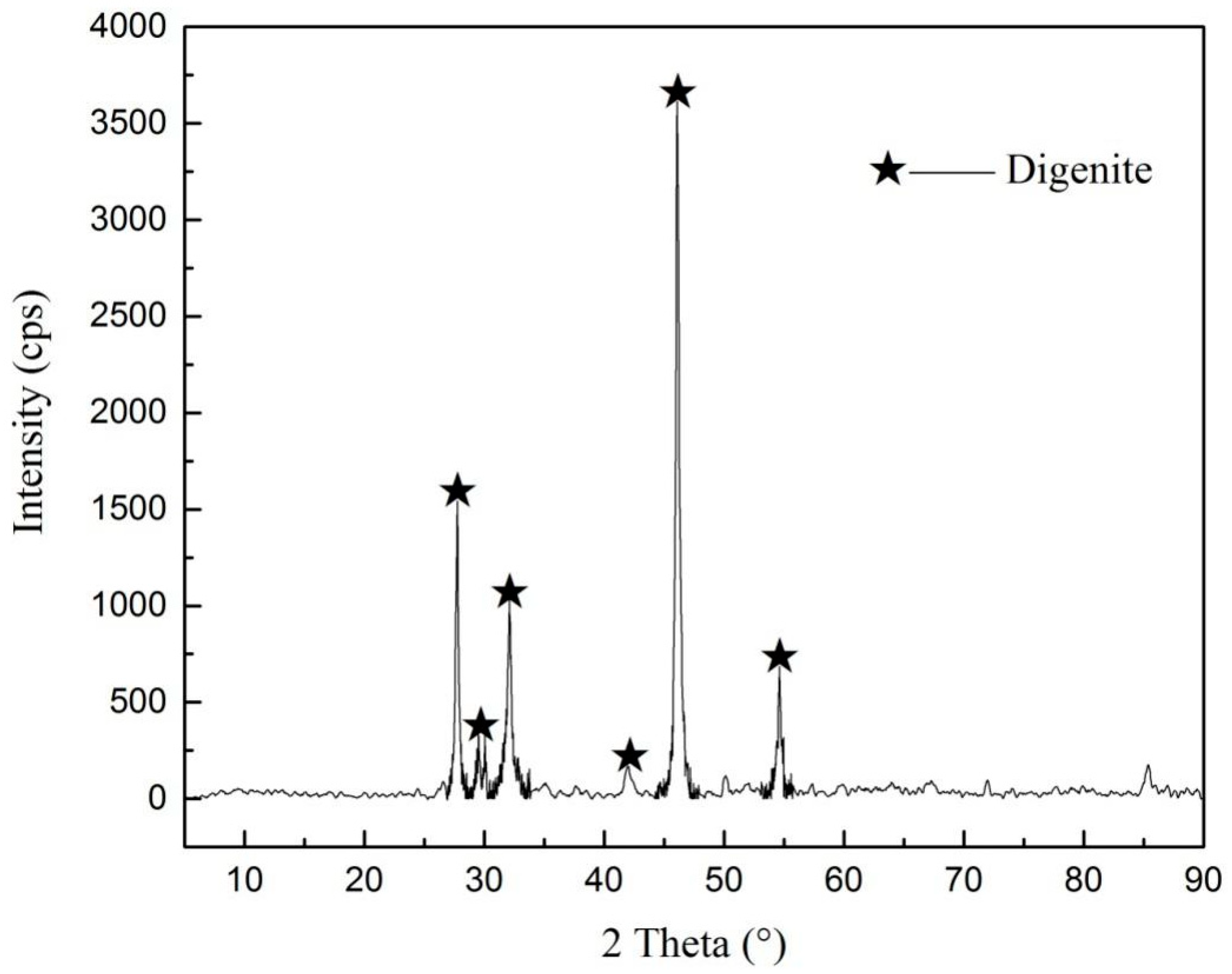
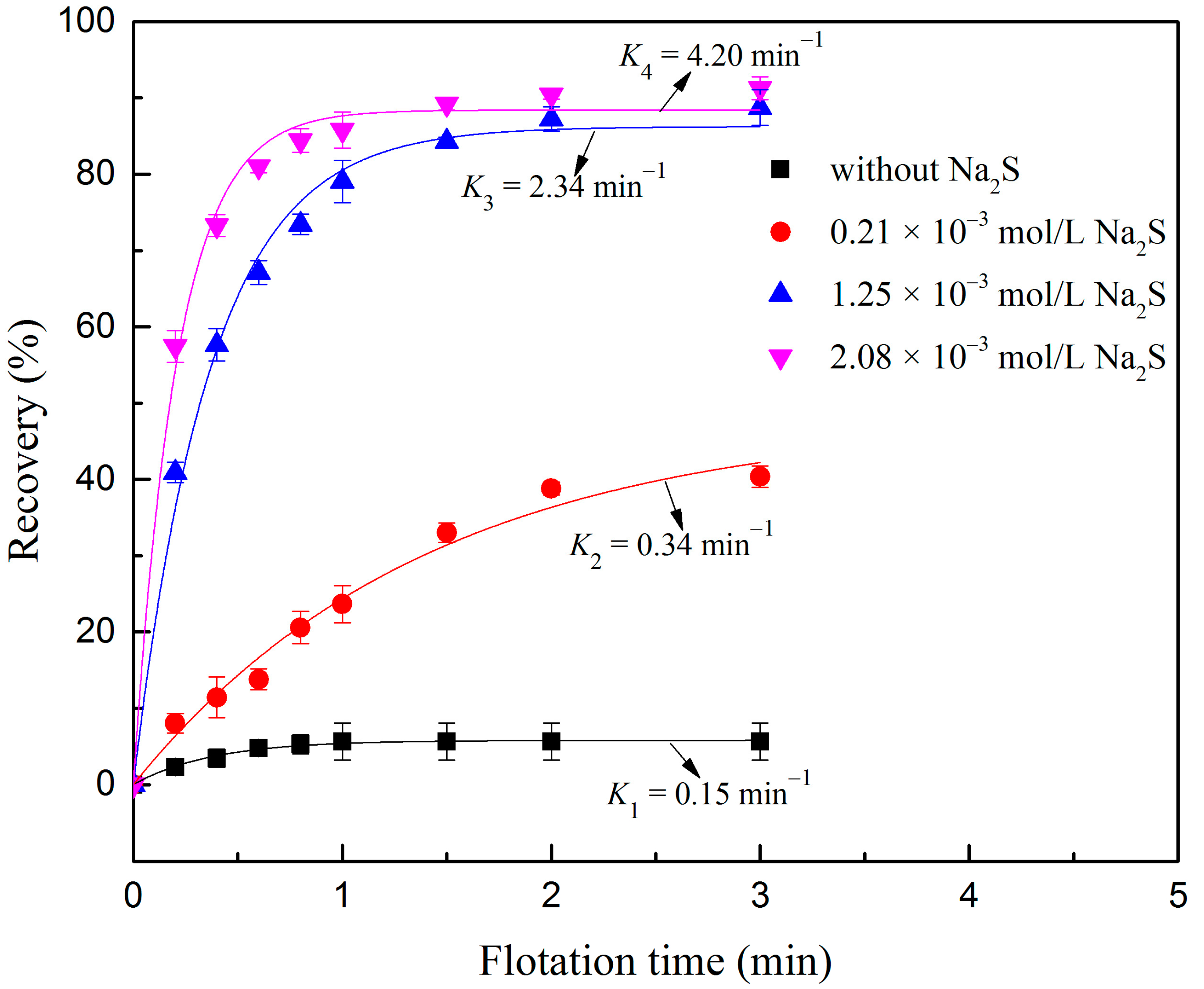



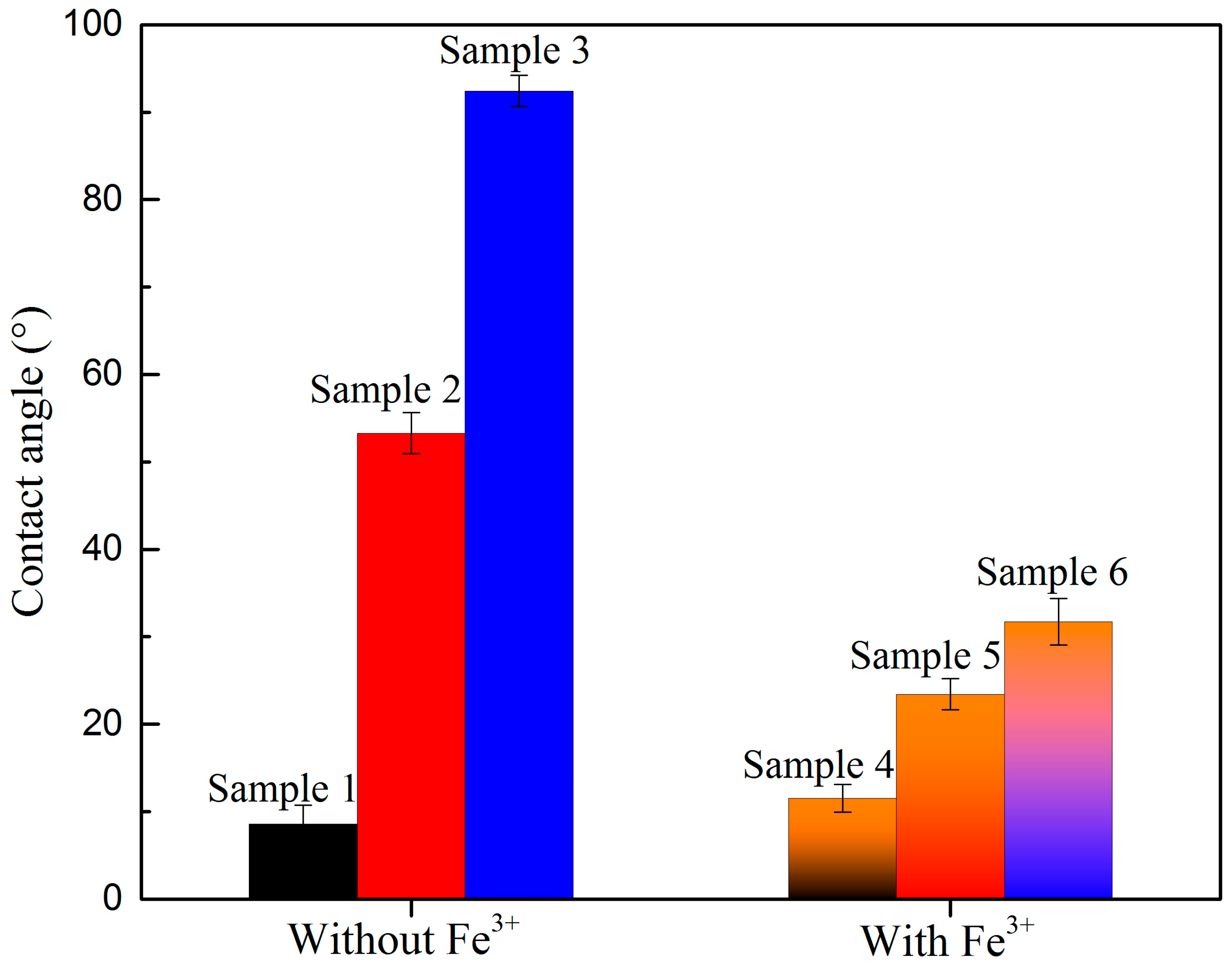

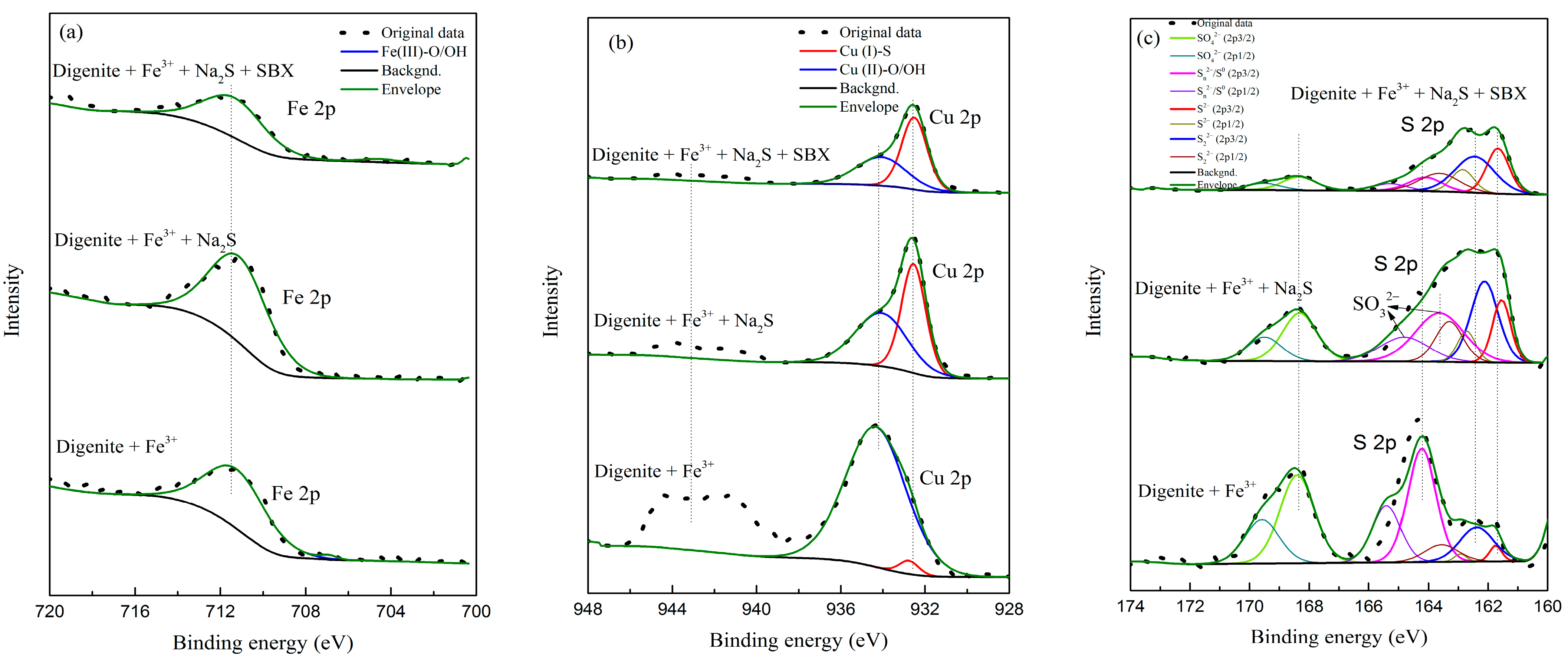

| Species | DI Water | Na2S | Na2S + SBX | |||
|---|---|---|---|---|---|---|
| B.E. | at.% | B.E. | at.% | B.E. | at.% | |
| Cu (I)-S | - | - | 932.51 | 65.61 | 932.39 | 89.01 |
| Cu (II)-O/OH | 935.07 | 100.00 | 934.59 | 34.39 | 934.24 | 10.99 |
| Species | DI Water | Na2S | Na2S + SBX | |||
|---|---|---|---|---|---|---|
| B.E. (eV) | at. (%) | B.E. (eV) | at. (%) | B.E. (eV) | at. (%) | |
| S2− | 161.51/162.69 | - | 161.58/162.76 | 18.36 | 161.65/162.83 | 37.94 |
| S22− | 162.07/163.25 | 25.71 | 162.00/163.18 | 61.56 | 162.26/163.44 | 51.40 |
| Sn2−/S0 | 164.55/165.73 | 7.47 | 164.57/165.75 | 5.82 | 164.44/165.62 | 0.94 |
| 2− | 168.98/170.16 | 66.83 | 168.07/169.25 | 14.25 | 167.70/168.88 | 9.73 |
| Species | Fe3+ | Fe3+ + Na2S | Fe3+ + Na2S + SBX | |||
|---|---|---|---|---|---|---|
| B.E. (eV) | at. (%) | B.E. (eV) | at. (%) | B.E. (eV) | at. (%) | |
| Fe(II)-S | 707.13 | - | 707.13 | - | 707.13 | - |
| Fe(III)-O/OH | 711.10 | 100.00 | 711.75 | 100.00 | 711.33 | 100.00 |
| Species | Fe3+ | Fe3+ + Na2S | Fe3+ + Na2S + SBX | |||
|---|---|---|---|---|---|---|
| B.E. (eV) | at. (%) | B.E. (eV) | at. (%) | B.E. (eV) | at. (%) | |
| Cu (I)-S | 932.76 | 2.94 | 932.54 | 49.02 | 932.52 | 58.98 |
| Cu (II)-O/OH | 934.34 | 97.06 | 934.06 | 50.98 | 934.16 | 41.02 |
| Species | Fe3+ | Fe3+ + Na2S | Fe3+ + Na2S + SBX | |||
|---|---|---|---|---|---|---|
| B.E. (eV) | at. (%) | B.E. (eV) | at. (%) | B.E. (eV) | at. (%) | |
| S2− | 161.75/162.93 | 2.54 | 161.55/162.73 | 15.41 | 161.67/162.85 | 30.08 |
| S22− | 162.38/163.56 | 15.33 | 162.12/163.30 | 30.01 | 162.45/163.63 | 42.88 |
| SO32− | - | - | 163.63/164.81 | 32.18 | - | - |
| Sn2−/S0 | 164.22/165.40 | 42.00 | - | - | 164.10/165.28 | 13.61 |
| SO42− | 168.40/169.58 | 40.14 | 168.32/169.50 | 22.41 | 168.33/169.51 | 13.43 |
Publisher’s Note: MDPI stays neutral with regard to jurisdictional claims in published maps and institutional affiliations. |
© 2021 by the authors. Licensee MDPI, Basel, Switzerland. This article is an open access article distributed under the terms and conditions of the Creative Commons Attribution (CC BY) license (http://creativecommons.org/licenses/by/4.0/).
Share and Cite
Xue, J.; Ren, D.; Wang, S.; Bu, X.; Song, Z.; Zhao, C.; Chen, T. Effect of Ferric Ions on Sulfidization Flotation of Oxidize Digenite Fine Particles and Their Significance. Minerals 2021, 11, 305. https://doi.org/10.3390/min11030305
Xue J, Ren D, Wang S, Bu X, Song Z, Zhao C, Chen T. Effect of Ferric Ions on Sulfidization Flotation of Oxidize Digenite Fine Particles and Their Significance. Minerals. 2021; 11(3):305. https://doi.org/10.3390/min11030305
Chicago/Turabian StyleXue, Jiwei, Dawei Ren, Sen Wang, Xianzhong Bu, Zhenguo Song, Chen Zhao, and Tong Chen. 2021. "Effect of Ferric Ions on Sulfidization Flotation of Oxidize Digenite Fine Particles and Their Significance" Minerals 11, no. 3: 305. https://doi.org/10.3390/min11030305
APA StyleXue, J., Ren, D., Wang, S., Bu, X., Song, Z., Zhao, C., & Chen, T. (2021). Effect of Ferric Ions on Sulfidization Flotation of Oxidize Digenite Fine Particles and Their Significance. Minerals, 11(3), 305. https://doi.org/10.3390/min11030305





